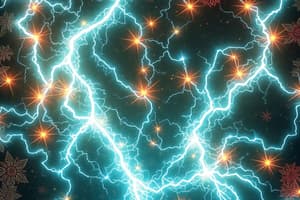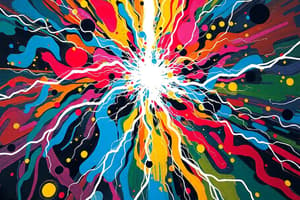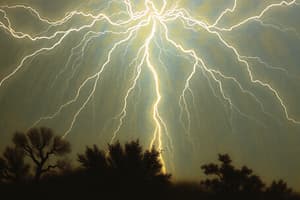Podcast
Questions and Answers
Which of the following is the BEST description of static electricity?
Which of the following is the BEST description of static electricity?
- The accumulation of electric charge on an insulating surface. (correct)
- The continuous flow of electric charge through a conductor.
- The process of converting chemical energy into electrical energy.
- The energy produced by a moving magnet.
Charging by induction results in a temporary charge only.
Charging by induction results in a temporary charge only.
False (B)
Explain in one sentence why static electricity is unsuitable for powering most electrical devices.
Explain in one sentence why static electricity is unsuitable for powering most electrical devices.
Static electricity is not used to power devices because it does not provide a continuous flow of electric charge.
A material that allows electric current to flow easily is called a(n) ________.
A material that allows electric current to flow easily is called a(n) ________.
Match each electric cell component with its correct role:
Match each electric cell component with its correct role:
What is the primary difference between a primary cell and a secondary cell?
What is the primary difference between a primary cell and a secondary cell?
Direct current (DC) flows in one direction while alternating current (AC) periodically reverses direction.
Direct current (DC) flows in one direction while alternating current (AC) periodically reverses direction.
Name two sources of electrical energy.
Name two sources of electrical energy.
The part of an electric cell that conducts electric current through the movement of ions is called the ________.
The part of an electric cell that conducts electric current through the movement of ions is called the ________.
Match the following parts of a circuit to their descriptions.
Match the following parts of a circuit to their descriptions.
In a series circuit, what happens to the current?
In a series circuit, what happens to the current?
Voltage is the measure of electric current and is measured in amperes.
Voltage is the measure of electric current and is measured in amperes.
What is the unit of measurement for resistance?
What is the unit of measurement for resistance?
A device used to measure potential difference (voltage) is called a(n) ________.
A device used to measure potential difference (voltage) is called a(n) ________.
Match the material with its typical level of electrical resistance:
Match the material with its typical level of electrical resistance:
According to Ohm's Law, how are voltage (V), current (I), and resistance (R) related?
According to Ohm's Law, how are voltage (V), current (I), and resistance (R) related?
Increasing the length of a wire decreases its electrical resistance.
Increasing the length of a wire decreases its electrical resistance.
List two factors that affect the resistance of a wire.
List two factors that affect the resistance of a wire.
A resistor is a circuit component designed to ________ the flow of electric current.
A resistor is a circuit component designed to ________ the flow of electric current.
What is the BEST way to approach solving for values related to voltage, current, and resistance?
What is the BEST way to approach solving for values related to voltage, current, and resistance?
Flashcards
Static Electricity
Static Electricity
The buildup of electric charge on a surface. It is stationary.
Laws of electric charges
Laws of electric charges
The fundamental rules governing how electric charges interact, including attraction of unlike charges and repulsion of like charges.
Charging by conduction
Charging by conduction
Transfer of charge through direct contact.
Charging by induction
Charging by induction
Signup and view all the flashcards
Electric Discharge
Electric Discharge
Signup and view all the flashcards
Electroscope
Electroscope
Signup and view all the flashcards
Current electricity
Current electricity
Signup and view all the flashcards
Conductor
Conductor
Signup and view all the flashcards
Insulator
Insulator
Signup and view all the flashcards
Electrochemical cell
Electrochemical cell
Signup and view all the flashcards
Electrolyte
Electrolyte
Signup and view all the flashcards
Electrodes
Electrodes
Signup and view all the flashcards
Battery
Battery
Signup and view all the flashcards
Direct current (DC)
Direct current (DC)
Signup and view all the flashcards
Alternating current (AC)
Alternating current (AC)
Signup and view all the flashcards
Electric circuit
Electric circuit
Signup and view all the flashcards
Resistance
Resistance
Signup and view all the flashcards
Ohm
Ohm
Signup and view all the flashcards
Series circuit
Series circuit
Signup and view all the flashcards
Parallel circuit
Parallel circuit
Signup and view all the flashcards
Study Notes
- The following is a physics test checklist
Static Electricity
- Includes concepts and diagrams (e.g. objects touching)
- Includes drawing charges
Concepts:
- Electricity
- Static electricity
- Laws of electric charges
- Charging by friction, conduction, and induction (temporary and permanent)
- Electrostatic series
- Electric discharge
- Lightning
- Lightning rod
- Grounding
- Electroscopes (pith ball and metal leaf)
Introduction to Current Electricity
- Knowledge of the differences between static and current electricity
- Current electricity is used to power devices, unlike static electricity
- Knowledge of the difference between a conductor and insulator
- Plastic covers the copper in conducting wire
Sources of Electrical Energy
- Batteries and electric generating stations are two sources of electrical energy
- An electrochemical cell exists
- Its parts include electrolyte and electrodes: anode, cathode
- A battery is different than a cell
- Primary and secondary cells are different
- Wet and dry cells are different
- Direct current (DC) exists
- Some devices use DC
- Alternating current (AC) exists
- Some devices use AC
- Batteries and electric generating stations send a certain type of current
- Primary energy exists
- Electricity is a form of primary energy
- Electric energy is unique
Circuits
- An electric circuit exists
- A circuit might not work for multiple causes
- Parts of a circuit: load, energy source, switch, conducting wires, resistor, ammeter, voltmeter
- A switch may benefit a circuit
- Series and parallel circuits are different
- Current and voltage operate differently in series and parallel circuits
Voltage, Current, Resistance
- Electrical energy exists
- Potential energy exists
- Chemical potential energy can be described in cells/batteries
- When 2 terminals of a battery are connected something happens
- Electrons will flow in a circuit a certain direction
- A circuit completing "work" means something
- Potential difference/voltage exists, measured in volts
- A voltmeter is used for measurements
- Current exists, measured in amperes
- Resistance exists
- Conductors have low resistance
- Insulators have high resistance
- Resistance is measured in ohms
- A resistor exists
- Factors affecting resistance: material, temperature, length, diameter
Ohm's Law
- Voltage, current, and resistance are related (Ohm's Law)
- Voltage, current and resistance can be calculated
- The GRASS method helps show all work
Studying That Suits You
Use AI to generate personalized quizzes and flashcards to suit your learning preferences.




